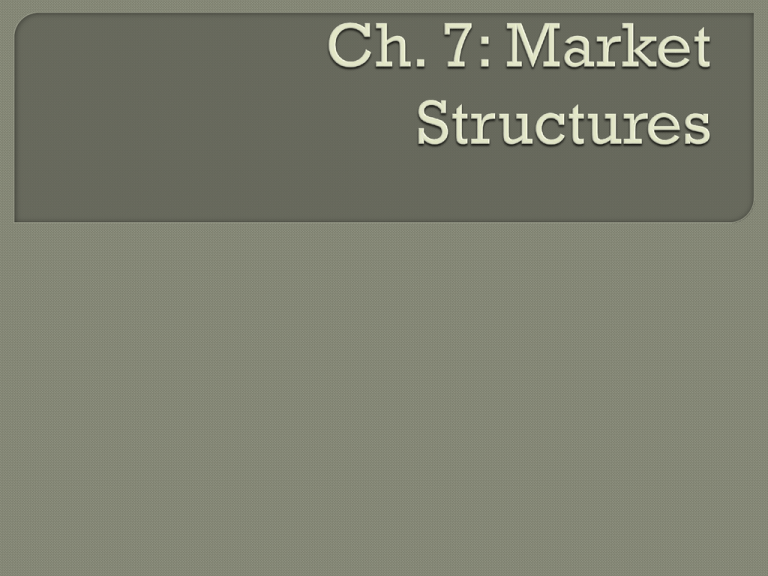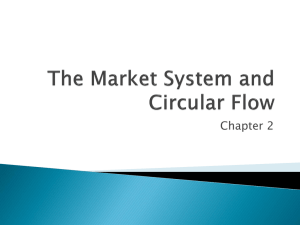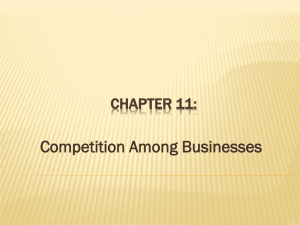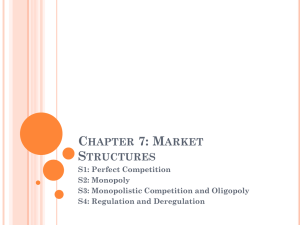Chapter 7 Powerpoint - Student
advertisement

Economists classify markets based on how competitive they are Market structure – Perfect competition – • useful as a model, but real markets are never perfect • economists assess how competitive market is by determining where it falls short of a perfect competition 1.– no one seller or buyer has control over price 2.– a product that consumers consider identical in all essential features to other products in the same market 3.– buyer and sellers are free to enter and exit the market, no govt. regulations prevent participation nor is any business or custom required to participate in the market 4.– buyers cannot join other buyers and sellers cannot join other sellers to influence prices 5.– both buyers and sellers are well-informed about market conditions, buyers can do comparison shopping and sellers can learn what their competitors are charging • Price taker – is a business that cannot set the prices for its products but instead accepts the markets price set by the interaction of supply and demand • only efficient producers make enough money to serve perfectly competitive markets Large # of buyers and sellers necessary for perfect competition so that no one buyer has power to control the price in the market • many sellers – buyers can chose to buy from different producer if one tries to raise price above the market level • b/c many buyers – sellers able to sell product at market price ex – Smith family selling at Montclair Farmers’ Market – sell raspberries • many farmers grow and sell at market – charge same price if one tries to sell at higher price – buyers buy from someone else all know they can sell at market price b/c of sufficient demand In perfect competition – • products are perfect substitutes • ex. – eggs, milk, wheat, notebook paper, gold No 2 pints of raspberries are exactly alike – similar enough consumers will buy from any producer that offers raspberries • price is only basis to choose one product over another Perfectly competitive markets – • investment to enter is low • market forces encourage producers to freely enter or leave Smiths consider market price for raspberries when planting – if they can make a profit – grow it Perfectly competitive market – • buyers and sellers act independently • interaction of supply and demand set equilibrium price • independent action ensures market will remain competitive Perfectly competitive market – • buyers compare prices among different sellers • sellers know what prices competitors are charging and what buyers will pay In real world – no perfectly competitive markets b/c real markets do not have all of the characteristics of perfect competition Imperfect competition – • wholesale markets for beef & corn come close to perfect competition In US – thousands of farmers grow corn – no one farmer can control price of corn • all accept market price • can decide how much to produce to offer for sale Large # of buyers – price on wholesale market easy to determine • corn fairly standardized – • • • • buyers no reason to prefer one over another buyers will not pay more than market price reality – US govt. pays subsidies to farmers to protect from low prices some corn farmers band together to try & influence price of corn Many cattle producers and little variation in a particular cut from another • wholesale buyers primary concern is price • buyers and sellers can easily determine the market price • sellers can only adjust production to reflect market price Reality – • cattle ranchers may try to join together to influence the price of beef • producers try to persuade buyers that there are significant differences in product that warrant higher prices Perfect competition is the most competitive market structure Monopoly – • it is the least competitive market • term can be used for the market structure or monopolistic business • pure monopoly as rare as pure competition – some businesses come close Cartel – Price maker – a business that does not have to consider competitors when setting its prices • consumers either accept the price or do not buy the product Barrier to entry – • ex. – large size, govt. regulation, special resource, 3 technology characteristics of a monopoly – De Beers Diamonds A single business is identified with the industry b/c it controls the supply of a product that has no close substitute • De Beers once produced more than half of world’s diamond supply and bought the rest from smaller producers In some cases De Beers – worked with the South African govt. • new mines required to sell through De Beers • company restricted access to market for raw diamonds for producer outside South Africa Monopolists control prices b/c no close substitutes for their product & no competition • economic downturn reduced demand – De Beers created artificial shortage by withholding diamonds from the market • cartel could continue charging higher price Several reasons why monopolies exist and not all are harmful Natural monopoly – Govt. monopoly – is a monopoly that exist b/c the govt. either owns and runs the business or authorizes only one producer Technological Geographic monopoly – monopoly – is a monopoly that exists b/c there are no other producers or sellers within a certain region In some markets – • most public utilities fall into this category Water company – pumps water – through pipes to homes, businesses, public facilities • monitors water quality for safety, removes and treats wastewater • waste of community resources to have several companies do this same job Economic scale – • more customers – more efficient as high fixed costs are spread out • these economic scales get govt. support of natural monopolies • govt. regulates so do not charge excessively high prices Govt. run businesses provide goods & services that could not be provided by private firms or are not attractive due to insufficient profit opportunity • oldest govt. monopoly – • at first, only govt. could provide this in efficient and cost effective manner • today – new services and new technology chipping away also – people send by email, fax, text message, pay bills online 1947 – Edwin Land (founder of Polaroid) invented 1st instant camera • with patents – created monopoly in instant photography market Patent – • govt. support tech. monopolies by issuing patents • patents allow business to recover costs in developing invention or technology Polaroid controlled technology through its patents & a barrier for other firms • 1985 – Polaroid won lawsuit against Kodak for patent infringement • blocks Kodak from instant photography market Technology monopolies last as long as the patent – generally 20 years • or when new technology creates a substitute-new tech for instant camera – easy to use 35mm, one hour photo processing, digital cameras Today – instant camera is minor segment of photography market Major sports require teams be associated with a city or region & limit # on teams in each league • leagues create a restricted market • most teams draw fans from large surrounding geographic region • owner are able to charge higher prices for tickets than if there was competition • also have a ready market for apparel & merchandise with logo & colors Physical isolation is creates geographic monopoly – gas station in middle of desert off interstate • Joe only supplier of gas with no close substitute • drivers can either buy gas or risk running out • Joe can control the price & its expensive Geographic monopolies have become less common in US – people can travel greater distances, catalog orders, internet business Monopoly is only firm with product – cannot charge any price • still faces a downward sloping demand curve – ie. will sell more at lower prices Monopolist can cause demand by causing a shortage of the product – artificially raising the equilibrium price • most countries have laws preventing monopolies Pharmaceutical Manufacturers – • drug patents generally last 11 years in US • try to maximize profits until patent runs out – then face competition from generic drugs Generic drugs – Claritin – approved as prescription in 1993 – but patented earlier • did not make users drowsy – became top seller - $3 billion in annual sales • patent expired in 2002 – generic came out – sales dropped to $1 billion in annual sales Most markets in real world fall between models of perfect competition & monopoly Monopolistic competition – • eg. – T-shirts with images or slogans market is competitive due to many buyers and many sellers • monopolistic b/c sellers have influence over a small segment of the market with products that are not exactly like those of competitors Distinguishing features – product differentiation & non-price competition Product differentiation – • ex – substantial differences – gas mileage ratings • ex – life of batteries – reality - difference in battery life is minimal Nonprice competition – • the cool gizmo from a fast food chain 1. Many buyers for many sellers 2. Similar but differentiated products 3. Limited lasting control over prices 4. Freedom to enter and exit the market In monopolistic competition – • perfectly competitive market - # of sellers is usually smaller – but enough for meaningful competition • sellers act independently in choosing what product to make, how much & price Hamburgers – • no seller has a large enough share of market to control supply of price • the restaurants with your favorite have a monopoly on your business though In monopolistic competition – sellers gain limited monopoly by making a distinctive product or convincing consumers that their product is different from the competition Burgers – restaurants will say quality of ingredients or way its cooked • distinctive packaging, money back guarantee if unhappy • one way to win over is with brand names & encouraging loyalty • advertising informs consumers of differences How to decide to differentiate burgers – market research • gathering and evaluating info about consumer preferences for goods & services • for local – listening to consumer praise & complaints & competitors Focus group – • used by large chain restaurants to gain consumer lifestyles and product preference Surveys – Product differentiation give producers limited control of price • charge different prices based on how they want to appeal to customers • low priced burgers for parents of young eaters on tight budget • name brand burgers with better ingredients are higher priced if differences are important enough – consumers will pay • if price goes too high – consumers will switch to substitutes and producers know this No huge barrier to enter this type of market • to open burger stand – not need for huge amount of capital • when firms earn profit – other firms will enter & increase competition increased competition means finding ways to differentiate the product • competition more intense for smaller businesses rather than larger businesses • those firms that take losses – signals time to get out In restaurant market – sell off equipment - if finances are solid – look for new market Oligopoly – • a few large firms have a large market share and dominant the market Market market share – a percent of total sales in a • movies – movie (only a few major studios), theaters (only a few chains) – oligopolies Start-up costs – • few firms due to high start-up costs • making a movie – expensive if to compete with major studios, need network of promoters & distributors 1. Few sellers but many buyers 2. Industrialized market – standardized product & in consumer market – differentiated product 3. Few prices 4. To sellers have more power to control enter or exit market is difficult A few firms dominant the entire market • not a single supplier – but fewer firms than in monopolistic competition • produce a large part of the total product in the market Economists consider an industry to be an oligopoly if the 4 largest firms control 40% of market • half of manufacturing industries in US fall into this Breakfast industry in US dominated by 4 firms who control 80% • lots of variety of cereal – but less competition Depending on market – will sell one or the other • many industrial products are standardized and a few large firms control this ex – steel, aluminum, flat glass • firms differentiate based on brand names, service, location Consumer products offered are differentiated • ex – breakfast cereals, soft drinks Market product using strategies similar to monopolistic competition • use surveys, focus groups & market research techniques to find likes • brand names can be marketed across country and world Few sellers – • each breakfast cereal maker has enough of a share of market – that decisions made about supply and price affect the market as a whole • seller in oligopoly is not as independent as seller in monopolistic competition • decision made by one seller may cause other to respond in the same way ex – if one seller drops prices – others will follow so not to lose customers ex – but if one raises prices – other will not follow so to try and gain customers • firms in an oligopoly try to anticipate how competitors will respond to actions before making decisions on price, output or marketing Start-up costs can be extremely high • entering breakfast cereal industry on small scale is not very expensive – but low profits • to compete against the majors – need factories, warehouses & other infrastructure – is expensive also – manufacturers may hold patents Firms in oligopolies have establish brands and plentiful resources – make it tough for new firm • manufacturing firms have agreements with grocery stores for best shelf space • existing manufacturers have economies of scale to help expenses low smaller firms lack economies of scale Investment in an oligopoly make it difficult to leave the market • when major breakfast cereal maker losses money – too vast and complex to sell and reinvest • must trim operation & stimulate demand for its product Each structure had different benefits & problems • each creates different balance of power between producer and consumer Consumers get most value in markets that approach perfect competition • no perfect competitive markets • prices set by supply and demand • a standardized product - consumers have little choice other than best price Monopolistic competition – • -businesses gain some control over prices – more likely to earn profit • -opening a business in this is relatively affordable Oligopoly – • -businesses gain more control of price – making it easier to earn a profit • -cost to do business in this market is high Monopoly – • -faces little or no competition from other companies • -consumers the least amount of influence over price • -consumers decide only whether they are willing to buy the product at the price British economist – b. Oct. 31, 1903 – d. Aug. 5, 1983 • one of the first to write about market structures 1933 – 1st major book – The Economics of Imperfect Competition • described market structures that existed between monopoly & perfect competition Came out shortly after Edward Chamberlin – Theory on Monopolistic Competition • developed ideas independently Described competition among firms w/differentiated products • firms gain more control over price – but control limited by amount of competition • described nature of oligopoly & monopsony Monopsony – market structure in which there are many sellers but only one large buyer • contributed important ideas her whole career • theory of imperfect competition remain key element of field of microeconomics Her ideas more accurately reflected modern market economies in which firms compete through product differentiation and advertising and in which many industries are controlled by oligopolies Forces of marketplace usually keep businesses competitive w/one another & attentive to consumer welfare Regulation – Antitrust legislation – laws that define monopolies and give govt. the power to control them and break them up • most important laws that promote competition Trust – • govt. regulates business mergers to keep trusts from forming Merger – is when one company combines with or purchases another to form a single firm Late 1800s – a few large trusts dominated oil, steel & railroad industries in US • govt. worried would use power to control price & output 1890 – • gave govt. power to control monopolies and regulate business practices that might reduce competition • other laws strengthened govt. ability to regulate business & encourage competition Ex – late 1880s – Standard Oil – gained control of 90% of US oil industry • could set production levels & prices 1911 – US won lawsuit to force a breakup of the trust • forced to give up control of 33 companies that were in the trust At various times – • govt. might allow large firm to remain intact b/c most efficient producer May also order company to change business practices to allow other firms compete more easily Responsibility for enforcing antitrust legislation: • 1. Federal Trade Commission (FTC) • 2. Department of Justice major focus is assessment of mergers • govt. supports mergers that will benefit consumers Larger firms that are able to operate more efficiently and lower operating costs – lead to lower costs for consumers Govt. blocks mergers that lead to greater market concentration in the hands of a few firms • merger that makes it more difficult for new firms to enter cause concern To evaluate a merger – • company proposing a merger would define a market as broadly as possible to make its control seem smaller ex – soft drink producer might say its market is all beverages – water, tea, juice Determine whether merger will increase concentration in the market and decrease competition, govt. considers the market share of the firms before and after the proposed merger • looks at whether the merger allows a firm to eliminate competitors • will deny merger if analysis shows reduced competition & possible higher prices Govt. tries to make sure that businesses do not engage in practices that would reduce competition • when businesses take steps that counteract effects of competition, prices go up and supplies go down In US – laws prohibit most of these practices Business that seek to counteract market forces can use a variety of practices Price fixing – • similar – when businesses agree to restrict their output – driving up prices Mid-1990s – 5 major recorded music distributors began enforcing a “minimum advertised price” – for CDs sold • result – CD price remained artificially high 2000 – FTC reached agreement to end anticompetitive practice Market allocation – • by staying out of each other’s territory, businesses develop limited monopoly power & can charge higher prices • ex – early 1990s – agribusiness Archer Daniels Midland – conspired w/companies in Japan & Korea to divide world market for lysine (additive in livestock feed) also conspired w/European companies for citric acid – additive to soft drinks • agreements also included price fixing Department of Justice charged them with antitrust violations • pleaded guilty & paid $100 million in fines Business can use anticompetitive methods to drive other firms out of business Predatory pricing – • can be difficult to distinguish from competitive pricing Cease and desist order – a ruling that requires a firm to stop unfair business practices Public disclosure – which requires business to reveal product information to consumers • protects consumers and promotes competition by giving consumers the info they need to make informed buying decisions Govt. – enforces laws to ensure competitive markets & regulating other aspects if business • Federal Trade commission – promoting competition & preventing unfair business practices • Federal Communications Commission and Securities and Exchange Commission regulate specific industries • Food & Drug Administration, Environmental Protection Agency, Consumer Product Safety Commission – regulate multiple industries to ensure the safety and quality of specific products and to protect consumer health Govt. regulation in 20th Century focused on controlling industries 1970s – trend toward deregulation Deregulation – • has benefits & drawbacks – generally results in lower prices for consumers • deregulation may lead to fewer protections for consumers Airline Deregulation Act of 1978 – removed all govt. control of airline routes & rates • only safety regulation remain in place • result – new carriers entered the market & industry expanded Greater efficiency – prices fell 10-18% - most sharply on heavily traveled routes • more people now traveled by air due to lower prices Quality of service fell • cuts in food & other in- flight amenities • crowded airports • took time for local govt. to expand facilities Financial pressures led to large # of bankruptcies of airline companies • increased layoffs, lower wages, loss of pensions









